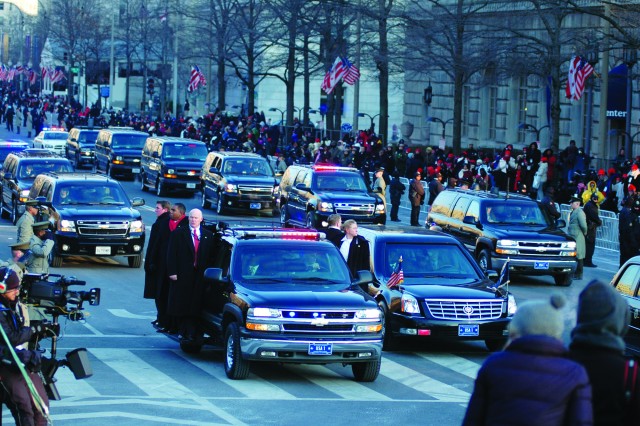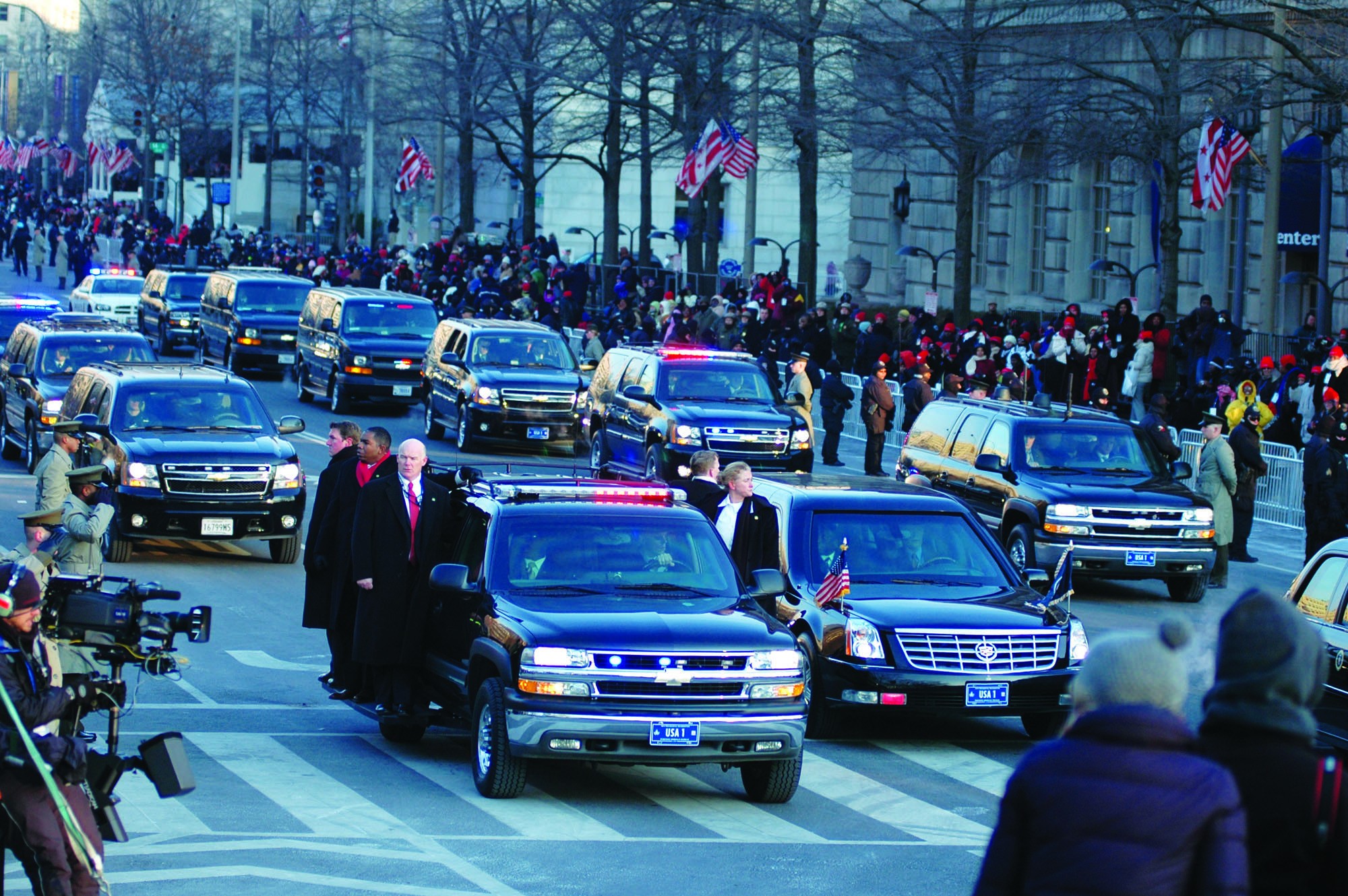It looks just like any other parking garage in northwest Washington, D.C., a sliding metal door, no markings on the building. What's inside, however, is very different from a typical parking garage.
A fleet of black vehicles, sporting mirror-like shines, as well as a staff of people who look like Secret Service agents fill this particular building. They may have the dark suits and earpieces, but they aren't Secret Service agents. They're noncommissioned officers in the United States Army.
The White House Transportation Agency is staffed by NCOs who have been given the responsibility to transport senior executives in the government, as well as family and guests of the president. It is the only operational unit that is staffed fully by Army NCOs.
A typical weekday at the WHTA might include taking National Security Advisor James L. Jones someplace in the city, picking up "First Granny" Marian Robinson, President Barack Obama's mother-in-law or taking a clerk from the White House to the U.S. Capitol, accompanied by a bill with the president's fresh signature on it.
"It might not be as glamorous as working on Air Force One or Marine One, but it's critical that NCOs do their job for the president and his family," said Maj. Marc Mueller, director of the WHTA. "It's one of those behind-the-scenes jobs."
President William H. Taft was the first president to receive a pool of automobiles in 1909. In 1911, the White House Garage was built as part of the Army Quartermaster Stables on the corner of 19th Street and Virginia Avenue in northwest Washington, D.C.
NCOs began serving as chauffeurs in 1926, and by 1947, they were all Army NCOs.
In 1963, the unit was placed under the operational control of the White House Military Office. It came under the jurisdiction of the Military District of Washington in 1964, when it was moved from the Office of the Chief of Transportation.
Because it is a four-year assignment, Soldiers are rarely at the WHTA for multiple presidents, which made this year's inauguration especially challenging.
"For a two-week period, we essentially had two administrations to cover," Mueller said. "We briefed the new staff, and provided trip support for the incoming president and his family, while we supported President Bush up to his final flight to Texas."
Other responsibilities for the WHTA include the trip support for the president on Air Force One, the First Lady's plane, White House staff plane and the press corps charter aircraft that follow the president. Soldiers at the WHTA are responsible for safeguarding baggage and cargo for trips all over the world.
This includes any cargo that might be added along the way, such as a gift given to President Bush while visiting Saudi Arabia.
"They gave [President Bush] a gold replica of his ranch," said Master Sgt. John Collier, senior operations sergeant for WHTA. "It took a few people to lift it up and get it aboard."
The building that houses the WHTA used to be a Cadillac dealer, which explains a floor plan that consists of mostly parking spaces. It is open 24 hours a day, seven days a week, so there is a full kitchen and break room for the Soldiers on duty.
The kitchen wall is lined with autographed photos from some of the WHTA's more famous passengers, such as Jimmy Buffett, Tony Dorsett and the Dallas Cowboys cheerleaders.
The wall between the kitchen and the break room features signed photos of even more famous people who were never quite passengers, but appreciated the WHTA's service nonetheless. Presidents Truman through George H.W. Bush each had a portrait signed with a personal thank-you.
"Working for the White House Transportation agency has been a life changing event for me. When I was nominated back in 2004 to come here, I had no idea the military worked for the president in any capacity. The job I do is different than anything I have done in the military," said Sgt. 1st Class James Bender.
"Working here has given me a wide variety of knowledge when it comes to the inner workings of the government. It has also given me the chance to further my education. I believe if you are in the Army and you are a good NCO, send in an application to come to the agency; if you are accepted it will be a something you will remember for the rest of your life."
The building also contains a Soldier who can perform basic maintenance on the vehicles and a maintenance bay with a lift. There is a car-wash station that helps keep the cars free from the salt and grit that adorn so many cars around this time of year. The cars come out of the building with a shine that would make any drill sergeant proud.
The WHTA is looking for capable Soldiers, but that doesn't mean it will be easy to be one of them. In 2008, they received 196 nomination packets, and only five Soldiers made it through the clearance.
"I never envisioned working for the White House Transportation Agency when I joined the Army. Frankly, I never knew an assignment like this one existed," said Master Sgt. Julio Maldonado. "I was skeptical when I received a call and was told I had been nominated to perform White House Transportation duties. I thought one of my Soldiers was playing a trick on me. It all became real when two security agents interviewed me in Texas and showed me their White House credentials."
"It's a very difficult unit to get into," Mueller said. "We want to see demonstrated leadership and above average potential for promotion. We also prefer the Soldier to have served in Iraq or Afghanistan."
Candidates must go through more than 540 hours of driver training, both from the Secret Service and other trainers. A top secret clearance is a start, but it's just the beginning of the high-level clearance needed for candidates. After a year of training, candidates receive the Presidential Service Badge.
"You also have to look the part," Mueller said. "We are the face of the Army at the White House."
The WHTA has its own dispatch center where Soldiers keep track of the day's schedule and monitor situations as needed, including dispatching drivers on short notice. The support provided doesn't mean that Soldiers in the field are constantly waiting for word from headquarters.
"Our NCOs are professional, independent and reliable," Collier said. "When they're on their own, they need to make on-the-spot decisions."
The WHTA will be undergoing a change in the coming months. The new administration has made "green" vehicles a priority, which means that the WHTA will soon be switching over to hybrid cars.
The dark suit might be different than the camouflage fatigues an average Soldier is used to, but the NCOs of the WHTA are far from average.
"We entrust these NCOs with a much higher degree of responsibility than other militaries do," Mueller said. "That's why we take such pride in our NCO Corps."


Social Sharing